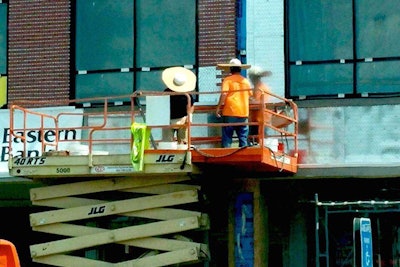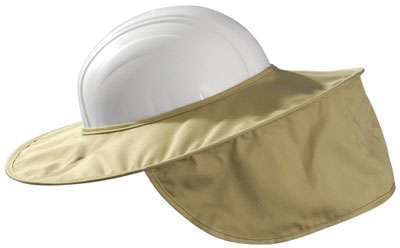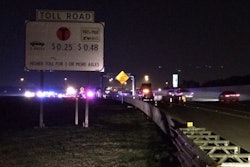 Credit: Reddit user DweadPiwateWoberts/reddit.com/dweadpiwatewoberts
Credit: Reddit user DweadPiwateWoberts/reddit.com/dweadpiwatewobertsIn the right conditions, the human mind can be pretty resourceful. The minds of construction workers—belonging to such an industrious and resourceful lot—are not exempt.
The photo above is a perfect example. Uploaded to Reddit by user DweadPiwateWoberts, it shows a couple of workers who have decided to beat the heat with some makeshift hard hat sombreros. From the looks of the photo, the pair cut a couple of doughnut-shaped pieces out of cardboard and fit them over their hard hats.
As DweadPirateWoberts observed, the trick is pretty “brilliant.” However, as conversations regarding construction tend to go, the talk on Reddit around the photo quickly turned to whether or not this type of thing was compliant with Occupational Safety and Health Administration regulations for head protection.
Turns out, it’s kind of a complicated question.
The hard hat sombrero or “shade” is already on the market as an actual product in two forms. The first is a removable hard hat shade or sun shield made by OccuNomix, ERB and MSA. You can find them in a few places online including Amazon. At the Texas America Safety Company site you can find all three varieties ranging from $6.50 to $18.50 a piece.
The second product is known as a western-style hard hat. It looks exactly like a cowboy hat and can also be found at TASCO for around $25.
Unfortunately, it’s not immediately clear whether these products are OSHA-compliant. Neither their listings on TASCO or on the manufacturers’ websites mention OSHA standard compliance. And the simple fact that you can buy one online does little to ease the worries of many employers who take safety seriously.
 An OccuNomix hard hat sun shade.
An OccuNomix hard hat sun shade.So I set out to find an answer to the question using official OSHA responses to hard hat-related questions. First, I wanted to get an understanding of OSHA’s stance on workers making personal modifications to hard hats. As of right now, OSHA has not addressed sun shades—DIY or otherwise—specifically. But they have commented on the most common modification: stickers and paint.
In a standard interpretation issued October 27, 2009, OSHA responded to a letter from Johanna Cohan asking whether stickers or paints were allowed on hard hats. OSHA said that while neither its personal protective equipment standard (29 CFR 1910.132) or its hard hat standard (29 CFR 1926.100) contain provisions that expressly prohibit stickers or hard hat painting, those modifications could make it more difficult for contractors and other companies to comply with the provisions that are in effect under those standards.
“To ensure a helmet is and remains in a “reliable” condition, the helmet must be inspected prior to use for signs of dents, cracks, penetration, and any damage due to impact, rough treatment, or wear that might reduce the degree of protection originally provided and used and maintained in accordance with the manufacturer’s instructions,” the statement reads. “Paints and stickers may eliminate electrical resistance and—depending on the location and quantity—conceal defects, cracks, penetration, and any damage that would be otherwise readily identifiable during the employee’s inspection to ensure reliability.
Another concern is that paints, thinners, and solvents, as discussed in Appendix A of ANSI Z89.1-2003 and the appendices of the 1986 and 1997 versions, can also attack or damage the shell of a helmet and reduce protection.”
OSHA also notes that it defaults to the hard hat manufacturer’s instructions on such modifications. Most manufacturers say no to paint, but are OK with stickers as long as they’re placed at least 1/2 inch to 1 inch away from the edge of the hard hat.
What does that mean for sun shades?
Whether you’re buying one off the internet or cutting one out of a pizza box, check with your boss first. And if you are the boss and feel like these could be a great way to help your crew work more efficiently in the sun, make sure they don’t impede your ability to prove the hats they’re attached to are up to code.
Come to think of it, there’s a problem with that too.
In a standard interpretation from April 17, 2006, when OSHA was asked whether requirements “prohibit an employee from wearing a cap, scarf, or other item on his/her head, for purposes of cold weather protection, while wearing a hard hat,” the agency said as long as these types of accessories were specifically designed for use with a hard hat, they were OK.
That means if you’re an employer and feel like sun shades available on the market don’t affect the safety of your crews or make it hard for you to demonstrate the reliability of their hard hats, use of these shades is fine. Especially those manufactured by a hard hat maker specifically for use with their hard hats.
 An OccuNomix western hard hat.
An OccuNomix western hard hat.However, given this wrinkle, it’s probably not a good idea for contractors to allow use of DIY cardboard shades like our friends in the photo above. According to OSHA, “It is unlikely that an employer would be able to determine whether a garment not specifically designed to be compatible with a hard hat’s protective properties, in fact, compromised those properties. Consequently, as a practical matter, an employer typically would not be able to ascertain if its use violated 1926.100.” So, while you could probably argue DIY shades were designed for hard hats, but there’s no arguing that a guy or girl with a pair of scissors or a box cutter could properly “design” the shade to be “compatible with a hard hat’s protective properties.”
But what about western-style hard hats? After all, those don’t require any modifications. That’s a bit easier, since OSHA made its official stance known in a standard interpretation from December 31, 1998.
John Jones of Indiana brought the issue before OSHA asking whether these types of hard hats are compliant with OSHA’s standards, noting his concerns that “the hat presents a hazard because hot items could fall into the brim and get caught or the brim could be struck by something and would cause the hat to easily fall off the employee’s head.”
OSHA said these style of hard hats are OK as long as they meet the standard’s provision for meeting the impact testing requirements of ANSI standard Z89.1-1969. Furthermore, OSHA said that the potential for an object to strike the larger brim of the hats and knock the hat off does not make them non-compliant as it does not alter the fact that the hat meets the impact standard.
In the end, OSHA says the hats are fine but warns employers to use common sense as to when they are appropriate for use. “There may be circumstances where a hard hat with a brim would make it more difficult for an employer to protect the employee against the burn hazard, or where the brim would increase that hazard. In such a case a brim on a hard hat would be inappropriate. However, we cannot say that, as a general rule, a brim would necessarily increase the risk of being burned (in some situations it might provide protection against a burn).”
Each of these types of shade could give workers a respite from the sun’s glare and, technically, each of them are OSHA-compliant. But are they worth the headache of potential violations should an injury befall one of the wearers? That’s for each employer to decide.












